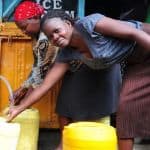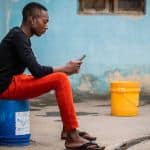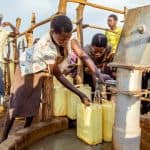New Solutions to an Old Problem: How the Internet of Things, Water Kiosks and Sensor Data are Improving Access to WASH in Kenya
Grant money for wells, while helpful, does not always mean access to clean water year-round. Often when well water systems break down, people can go days or even weeks without access to water for themselves and their livestock – both for drinking and sanitation/hygiene. Just imagine celebrating the installment of a new well near your village, only to have it become inoperable for days due to a lack of monitoring or maintenance.
The Kenya Resilient Arid Lands Partnership for Integrated Development – or Kenya RAPID for short – is a five-year development program convened by the Millennium Water Alliance that seeks to solve this problem by applying innovative technology and data for decision-making. The program believes that tech-driven tools can:
- reduce response time to breakdowns
- enhance transparency in water utility and accountability
- improve decision-making for investment resources
- increase uptake, and
- reduce non-revenue water
Kenya RAPID brings together public and private partners to increase access to water and sanitation for people, and water for livestock, and to rebuild a healthy rangeland-management ecosystem. From 2015 through 2020, it will target five Kenyan counties with high poverty rates, chronic food and water insecurity, and low access to basic services. If it is successful in increasing water access, this program is designed in such a way that it could be applied elsewhere.
Kenya RAPID leverages several technological innovations to help inform decision-making and increase financial sustainability. These include: prepaid water kiosks, water management as a service platform (WMaaSP), and SweetSense satellite-based sensors. Let’s take a look at these technologies and their impact on the ground.
Prepaid Water Kiosks
For all intents and purposes, a prepaid water kiosk functions like a water ATM. Consumers go to the kiosk and fill a prepaid card with money. Then each time they return to the kiosk, they simply swipe their card and select the number of liters they desire via the user interface, and the machine dispenses the amount that they have selected. The activities of each kiosk can be monitored by an administrator remotely.
This system increases revenues by dispensing the exact amount of water: There is less spillage, which means that each drop of water is being accounted for financially. Surprisingly, these water kiosks do not even need to have an attendant full time – currently they are maintained by a single attendant who visits them three times a week.
Water utilities and community-managed water schemes are constantly plagued by challenges like spillage/wasted water, long lines and misappropriation of funds due to cash-based systems run by corrupt practitioners. However, through the use of technology, private sector partners have developed a way to address each of these problems by using the kiosks. When paired with the WMaaSP, the possibilities for enhanced sustainability are increased immeasurably.
Water Management as a Service Platform (e-Maji)
E-Maji was developed in collaboration with IBM Research Africa. This web/mobile-based platform allows for water point mapping and tracking, and the management of boreholes. It does this by providing relevant information for decision-making to administrators, geared towards resource allocation, reducing system breakdowns/pump downtime, and improving accountability for water. The platform also hopes to bridge some knowledge gaps in hydrological and hydrogeological information.
SweetSense sensors were integrated into the platform (see below) for remote monitoring of boreholes. Information from Acacia Water is also included, using survey maps and relevant ground data to map and track potential interventions in the county. This innovation was intended to help management and government make informed decisions regarding WASH assets, to ensure improved access to reliable water.
SweetSense Satellite-based sensors
SweetSense is the leader in low-cost, remote sensors specifically designed for the global development sector. These sensors can be used to monitor water, energy and infrastructure projects. Each remote sensor sends data through a cellular or satellite connection. Once the data is collected, it is transmitted to an online database where project administrators can see performance in near-real time. The SweetSense database analyzes the data collected, and shows information in a visual format. By using SweetSense, partners gain the ability to know when a remote project needs repair, and how well the project is performing based on visual indicators. Rather than infrequent engagement, remote monitoring systems ensure that community partnerships are maintained through continuous feedback.
Without tools like remote sensors, the community or managers of a pump have to physically check if the pump is functioning when problems arise. That means the response time is delayed, which ultimately affects access and the reliability of each water pump, resulting in thirsty people and animals. In contrast, with SweetSensors and the dashboards they create – repair time is cut down immensely.
But while all of this tech is really cool, what happens when the project ends? How do these things remain sustainable without the implementers around to manage them? There are two ways that the Kenya RAPID program has been working to ensure the self-reliance of their WASH solution after the program ends: via commitment dimensions and capacity dimensions.
Commitment Dimensions
The RAPID program strategy involves strengthening the national and county governance and policy environment in the WASH and livestock sectors. This means that RAPID has been pushing for the development of county water sector policies and plans, along with water and sanitation legislation, rules and regulations – and effective public participation in this legislation. Besides strengthening intergovernmental relations, the RAPID team has been influencing county governments to increase public financial flows into this sector. This has already had some impact. For instance, water bills have been approved by the county assemblies of Turkana, Garissa and Marsabit and assented by the governors of these counties. Furthermore, through joint planning and implementation, the governments in the Kenya RAPID counties are increasingly allocating more resources to fund water infrastructure development activities. Finally, the national Council of Governors and Ministry of Water and Irrigation have embraced a framework for intergovernmental relations and coordination in the water sector.
The RAPID program is also empowering communities to effectively exercise their rights and responsibilities for their WASH and rangeland resources. It’s increasing the ability of communities to monitor and demand accountability for better service delivery, and strengthening their capacity to manage their own resources. Evidence of impact can be seen here as well. For example, the program has rolled out a complaints and feedback mechanism in its target counties, and 111,171 individuals had utilized the framework to share feedback as of the end of June 2019. The program has also facilitated 28 committees across the five counties to improve the management of rangeland resources.
Capacity Dimensions
RAPID engages in two strategies to build the government capacity of Kenya. First, it tries to deliver programs through a facilitation approach that aims to strengthen government systems and structures, improving county operation capacity in the WASH and livestock sectors. It finances capacity building and incentivizes market-driven solutions to government service delivery through its County Innovation Fund, which finances the individual capacity needs of frontline county government staff in WASH, livestock and rangeland management.
One of the most important goals of the Kenya RAPID program is to increase access to sustainable water for domestic and productive uses. For instance, RAPID is supporting counties to design and co-finance WASH infrastructure development to increase access to safe water. This program has improved access for over 335,000 people and almost 700,000 animals (camels, cattle, donkeys and sheep). Also, RAPID’s efforts to improve access to sanitation and hygiene have seen some success: Almost 4,000 household latrines and 239 institutional latrines have been constructed, which benefit over 37,600 people, and at least 20 villages have been declared “open defecation free.”
Finally, to boost the capacity of the economy, the RAPID program has partnered with private sector organizations to co-create tech solutions that enhance the availability of timely, reliable data for government decision-making. It has worked with county governments and others to support the development and digitization of grazing plans, and to strengthen private sector-led service delivery models for WASH. This approach has gained traction: Prepaid water metering, repair and maintenance models, point-of-use water treatment and more are being developed, and multiple county governments are promoting and co-financing public-private partnerships for WASH service delivery.
Why does this matter?
This work will mean more water for more people and livestock, requiring fewer resources for the upkeep and management of the wells. This means every dollar received in a grant or from a donor can be taken a step further. In addition, the success of the system put in place by the Kenya RAPID program could lead to its expansion to other areas, which will serve to provide safe, reliable access to clean water in parts of the world that have gone thirsty due to poorly maintained wells or boreholes. Finally, prepaid water kiosk technology prevents spillage and enhances sustainability in a way that will keep water flowing long past the end of a program’s lifecycle.
The RAPID program’s combination of tech-powered solutions are providing a long-term solution to an age-old problem. This is already making a significant impact on water access in Kenya – it will be interesting to see if similar solutions gain traction in other emerging countries.
The Kenya RAPID Program would not be possible without the generous support of the United States Agency for International Development (USAID) and the Swiss Agency for Development and Cooperation (SDC), or the hard work of Catholic Relief Services (CRS) and Millennium Water Alliance (MWA)!
Paul Wiedmaier works in ICT4D Knowledge Management at Catholic Relief Services.
Photo: Kenya Rapid Water Kiosk. Credit: Mikaele Sansone
- Categories
- Technology, Telecommunications, WASH
- Tags
- data, innovation, Internet of Things, water



